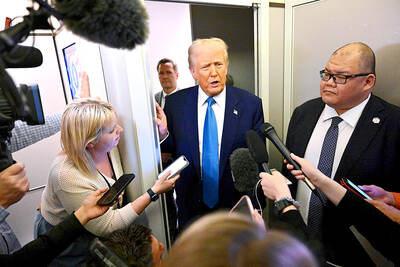Taiwan, China and Hong Kong are best placed in Asia to face accelerating inflation while Thailand, Indonesia and India are the most vulnerable, Morgan Stanley said.
The brokerage has moved “overweight” on Taiwan’s stocks, suggesting investors hold more of the country’s shares than are represented in benchmark indexes, analysts including Malcolm Wood and Ryan Tsai said. They recommend buying Taipei-based China Airlines Ltd (CAL, 中華航空) and selling Bangkok-based Siam Commercial Bank Pcl.
“China is best positioned in the region, given its absorption of record oil prices, decelerating food inflation, strong currency and low core inflation,” the analysts said in a report yesterday. “Thailand is suffering from its high oil intensity, rapidly accelerating food inflation, and rising core inflation.”
China’s overall consumer-price growth slowed to 7.7 percent last month from 8.5 percent in April, close to a 12-year high, the statistics bureau said last Thursday.
“We do recommend buying China because we think inflation has already peaked” and valuations are “pretty attractive,” Tsai said in a phone interview yesterday.
Morgan Stanley recommends buying Industrial and Commercial Bank of China Ltd (ICBC, 中國工商銀行), according to the report. ICBC, the nation’s biggest lender, retreated 25 percent from its Oct. 30 record.
PetroChina Co (中國石油天然氣) and China Mobile Ltd (中國移動通信) are also among Morgan Stanley’s model portfolio, according to the report.
PetroChina, the nation’s largest oil producer, has dropped 23 percent this year, while China Mobile, the world’s No. 1 cellphone operator by users, declined 21 percent.

When an apartment comes up for rent in Germany’s big cities, hundreds of prospective tenants often queue down the street to view it, but the acute shortage of affordable housing is getting scant attention ahead of today’s snap general election. “Housing is one of the main problems for people, but nobody talks about it, nobody takes it seriously,” said Andreas Ibel, president of Build Europe, an association representing housing developers. Migration and the sluggish economy top the list of voters’ concerns, but analysts say housing policy fails to break through as returns on investment take time to register, making the

‘SILVER LINING’: Although the news caused TSMC to fall on the local market, an analyst said that as tariffs are not set to go into effect until April, there is still time for negotiations US President Donald Trump on Tuesday said that he would likely impose tariffs on semiconductor, automobile and pharmaceutical imports of about 25 percent, with an announcement coming as soon as April 2 in a move that would represent a dramatic widening of the US leader’s trade war. “I probably will tell you that on April 2, but it’ll be in the neighborhood of 25 percent,” Trump told reporters at his Mar-a-Lago club when asked about his plan for auto tariffs. Asked about similar levies on pharmaceutical drugs and semiconductors, the president said that “it’ll be 25 percent and higher, and it’ll

NOT TO WORRY: Some people are concerned funds might continue moving out of the country, but the central bank said financial account outflows are not unusual in Taiwan Taiwan’s outbound investments hit a new high last year due to investments made by contract chipmaker Taiwan Semiconductor Manufacturing Co (TSMC, 台積電) and other major manufacturers to boost global expansion, the central bank said on Thursday. The net increase in outbound investments last year reached a record US$21.05 billion, while the net increase in outbound investments by Taiwanese residents reached a record US$31.98 billion, central bank data showed. Chen Fei-wen (陳斐紋), deputy director of the central bank’s Department of Economic Research, said the increase was largely due to TSMC’s efforts to expand production in the US and Japan. Investments by Vanguard International

WARNING SHOT: The US president has threatened to impose 25 percent tariffs on all imported vehicles, and similar or higher duties on pharmaceuticals and semiconductors US President Donald Trump on Wednesday suggested that a trade deal with China was “possible” — a key target in the US leader’s tariffs policy. The US in 2020 had already agreed to “a great trade deal with China” and a new deal was “possible,” Trump said. Trump said he expected Chinese President Xi Jinping (習近平) to visit the US, without giving a timeline for his trip. Trump also said that he was talking to China about TikTok, as the US seeks to broker a sale of the popular app owned by Chinese firm ByteDance Ltd (字節跳動). Trump last week said that he had